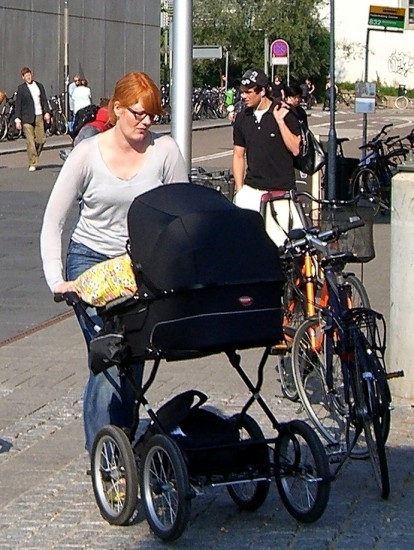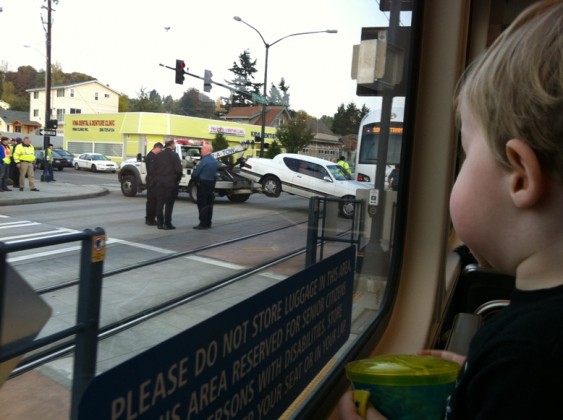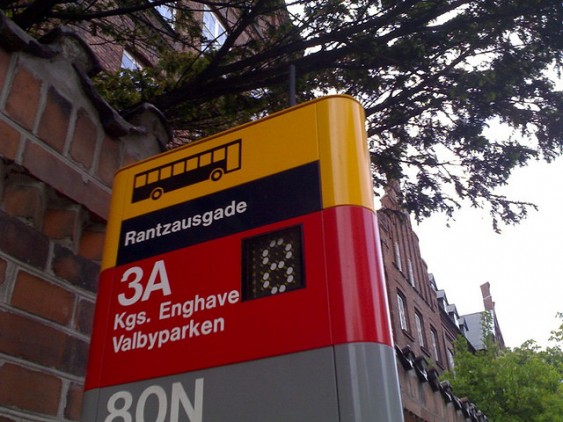Editor’s Note: As noted in the comments below, Seattle blogger Lynn Hamilton has started a petition on the topic of strollers.
I recall vividly how embarrassed I felt the first time I waited for the bus with my baby boy—he bundled up in his stroller and me expecting the bus driver to welcome me aboard, lowering the wheelchair lift so we could roll on in style. In the stores and sidewalks of my neighborhood, people smiled as we ran errands. They made way for us—slowing so we could pass on a congested sidewalk or holding doors open while we rolled into a shop. Then the bus arrived. Instead of lowering the lift, the driver told me to fold Orion’s stroller. My cheeks burned red as I hastily unpacked—diaper bag, toys, blanket, and groceries—while holding onto my squirming bundle of joy. Then, with one hand, I attempted to fold the stroller and carry the load aboard, knowing that everyone was watching me, passengers cursing under their breaths and the driver reviewing his timetable.
For most parents, an experience like that would have eliminated any thoughts of ever again taking their wheels on the bus. But I had no real choice.
My husband and I had committed to staying in our apartment overlooking The Ave, the main street running through Seattle’s University District. Some parents trade up to a minivan or SUV, but we had sold our two-door Civic. We gained a child and shed a car.

And, in most ways, I loved our car-free life. We explored our neighborhood together. People stopped to greet Orion on the sidewalk. I could point out interesting buildings or window displays. Outside our grocery store, the man selling the Real Change newspaper would always belt out, “Have a great day, little dude!” We soaked in the diversity of the city: new smells, sounds, and people. When we went somewhere in a car, Orion and I were both miserable. Seated in the backseat in his rear-facing car seat, he would often wail.

But King County Metro was the sore spot of my car-free life. Agency rules required me to fold Orion’s stroller. Holding all of the stroller’s contents and Orion, I then had to find a seat before the bus lurched forward. The challenge didn’t end once on board. I had to squish into a seat with all of our stuff and attempt to keep Orion from grabbing the stroller’s dirty wheels for the duration of the ride. Once we arrived at our stop, I had to reverse the whole ordeal.

My bus-riding fiascos led to an obsession with strollers: I was known to buy and sell them on Craigslist several times a month. My goal was to find that perfect stroller that I could really fold with one hand. I had a closet full of strollers, some undergoing testing and others, having failed, pending Craigslist pickup. It took seven strollers, but I found one that worked—the Britax Preview(pictured above).
It wasn’t until my young family spent six months in Copenhagen, however, that I thought much about King County Metro’s stroller-folding rules.

Copenhageners cart babies in enormous strollers (pictured above and below), rolling cribs that dwarf our umbrella stroller and do not fold at all.

And guess what? They are welcome aboard Copenhagen’s public transit, unfolded and unemptied.

Caregivers with strollers use priority seating at the front of the bus (as pictured below). While buses only fit two strollers at once, busy routes’ service is so frequent that the wait is never long.

Stroller-friendly policies extend to Copenhagen’s train system. The rapid transit system, Metro, has open areas on each train (below) that hold caregivers with strollers, riders in wheelchairs, and bicyclists.

Doors that open to this area feature a bicycle icon on the train platform where riders with wheels congregate. Bold graphicson trains also orient riders.

Car-free parenting in Copenhagen was a breeze: no more frantic stroller folding for me, and Orion loved staying in his stroller. Arriving back in Cascadia, I decided to see how other transit systems compared.
Portland’s TriMet buses are not much further along than Seattle’s King County Metro. Open strollers can be brought on board but then must be immediately folded. The only advantage to this policy is that it’s hard to forget the diaper bag at the bus stop. After deciding to be a one-car family, Portland mom Rachele wanted to take the bus to the grocery store with her son in a stroller. She timed her trip so it wouldn’t interfere with peak commuting hours. But Rachele learned that if she wanted to take the bus, she’d have to empty the stroller and hold her baby during the ride. Requesting tips from TriMet, the agency unhelpfully answered:
Dear Rachele: That is a tough one for you. Trimet’s policy is that you can leave the baby in the stroller while boarding but after boarding must take the baby out of the stroller, fold the stroller and hold the baby. I am not sure what you are going to do with your groceries. You may have to have someone go with you.
Light rail in both Portland and Seattle allow open strollers aboard low-floor cars. Sound Transit’s Central Link light rail, which connects downtown Seattle to SeaTac, opened after I had left for Copenhagen (and, more recently, a small town in Kitsap County). Local dad Brice Maryman, however, reports that Link makes car-lite parenting dreamy. He, his wife Bridgette, and their son Owen walk to the station daily, ride downtown together, and then drop Owen at daycare on their way to their offices. Before Owen, the couple commuted by bus, but Owen’s arrival changed everything. “Light Rail is just so much more kid friendly, and it’s a big reason why we decided to buy our house where we did,” says Brice. “We can leave the stroller open and sit on the seats with him between us.” Just like my son Orion, Owen prefers public transportation to driving. “Owen cries when circumstances dictate that we need to drive,” Brice says. (Pictured below, Owen watches as a tow truck clears the tracks of a vehicle whose driver tried to outrun Link.)

Like Copenhagen, Vancouver’s TransLink allows open strollers in the priority seating area at the front of the bus. If the area is already full or a rider with a mobility impairment boards, caregivers must fold their strollers and move back. TransLink has also committed to improving accessibility by purchasing low-floor buses since 1996. Low-floor buses and trains make it easier for all riders to board, no ramp necessary. A redesign of SkyTrain carsalso increased capacity by a third and provided more space for riders with wheels.
Beyond Cascadia, some places look better for stroller pushers. Like Vancouver and Copenhagen, the Chicago Transit Authority welcomes strollers aboard public transit. The CTA broadcasts its stroller-friendly policies with notice boards on buses and a YouTube video. While I had no clue that King County Metro required folded strollers, the CTA is making sure its policies are publicized. And I would have loved having Vancouver or Chicago’s pro-stroller policy in Seattle.
An open-stroller policy is a crucial first step that can make an immediate difference for moms, dads, and others across the Northwest who care for young children.

After that, opportunities abound. Once strollers are legalized aboard transit, agencies can announce the improvement, like the CTA has done with notices and videos. As buses and trains need replacement, agencies have the chance to purchase low-floor vehicles, which TransLink has made a priority. Improvements to bus and train stops can make it easier for caregivers with strollers. Chicago mom Jessie Williams wanted to take the train more often, but because only every fifth train station had an elevator, she rode the bus. Copenhagen’s bus stops had electronic transit-trackers that were linked to GPS on buses. You didn’t have to own a smart phone to know when the next bus would arrive, and instead of peppering you with the frequent, “When is the bus coming?” your child can watch the bus stop tracker count down the minutes.

Allowing strollers on buses may seem trivial. Only 6 percent of northwesterners are under five, the main stroller years. But all families need affordable alternatives to driving, our economy needs weaning from fossil fuels, and our whole society needs to move beyond carbon quick. With more strollers on the bus, fewer cars would clog the roads. Transit ridership would grow as caregivers transport tots to the doctor, play dates, and the grocery store. Parents could bring kids to daycare as they head to the office, building more family time into busy days. Welcoming stroller wheels onto buses and trains has long-lasting benefits—kids will grow up seeing public transit as a normal part of the daily routine.
The alternative is that we’ll raise another generation that sees driving as the norm. If we accommodate the youngest urban dwellers on transit, they will develop the skills to keep using transit as they grow. By age three, Orion could explain the differences between streetcars, light rail, and trains. When we were running errands, he would exclaim with pride, “Bus stop!” Then, he’d plant himself on the seat and ask when the bus would arrive. Now six, Orion is the member of the family responsible for pulling the cord when we near our stop. Bringing my wheels on the bus was often a challenge, but at least I know I’ve helped develop a transit habit in my son.


Comments are closed.